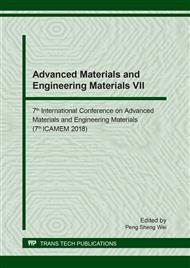p.245
p.251
p.256
p.262
p.268
p.272
p.277
p.282
p.289
Elevated pH on Bioleaching of Nandan Lead-Zinc Tailings as Building Materials
Abstract:
A series of the experiments were carried out on the Nandan lead-zinc tailings management and one bioleaching method was proposed with the purpose of recovering the valuable metal such as Zn. Firstly, multi-elements analysis was performed to provide theoretical data. Secondly, the effect of the pH on the bacterial growth and Fe2+ oxidation was investigated. The results showed that pH at 2.5 was the optimum for the bacteria. The concentration of the bacteria at pH 2.5 can be up to 9.3×107 cells/mL. Finally, the bioleaching treatment was performed to study the potential of bioleaching the tailings. The data illustrated that the method of bioleaching can extremely recover metals such as zinc from the tailings, which provided novel insights into metal recycling.
Info:
Periodical:
Pages:
268-271
Citation:
Online since:
August 2018
Authors:
Keywords:
Price:
Сopyright:
© 2018 Trans Tech Publications Ltd. All Rights Reserved
Share:
Citation:


